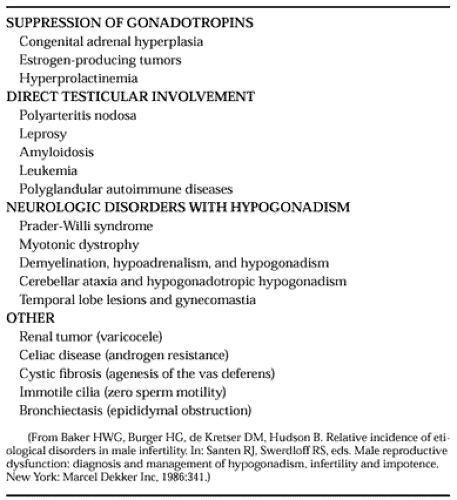DISEASES THAT ALTER TESTICULAR FUNCTION
The major acute and chronic systemic diseases that alter testicular function are listed in Table 116-1. Several conditions associated with testicular disorders by means of pituitary suppression, direct testicular involvement, generalized structural abnormalities, or unknown mechanisms are listed in Table 116-2. Details of the interaction between the male reproductive system and disorders in other body systems are covered in other sections of the textbook (see Chap. 13, Chap. 77, Chap. 115 and Chap. 118, and Parts XIV–XVII). A summary of the principal hormonal changes in several conditions affecting gonadal function is shown in Table 116-3.
TABLE 116-1. Conditions Associated with Suppression of Pituitary-Testicular Function | ||||||||||||||||||||||||||||||||||||||
|---|---|---|---|---|---|---|---|---|---|---|---|---|---|---|---|---|---|---|---|---|---|---|---|---|---|---|---|---|---|---|---|---|---|---|---|---|---|---|
| ||||||||||||||||||||||||||||||||||||||
ACUTE CONDITIONS WITH PERTURBATION OF HORMONE SECRETION OR SPERMATOGENESIS
Fever or heating the testes can suppress spermatogenesis.1,44,45 and 46 The suppression of serum gonadotropin or testosterone levels has been demonstrated during severe acute physical and psychological insults (see Table 116-1). The reduction in testoster-one levels is related directly to the severity of the critical condition and inversely to the prognosis.13,47,48 and 49 Recovery is usually associated with a transient rebound rise in serum LH before eventual normalization. Presumably, all result primarily from the temporary inhibition of GnRH secretion; however, altered hormone clearance and direct impairment of testicular function may contribute if circulatory changes, fever, activation of cytokine cascades, or other factors are influencing paracrine regulation.44,45,46,47,48,49 and 50
CHRONIC DISORDERS ASSOCIATED WITH TESTICULAR FAILURE
LIVER DISEASE
Hepatic cirrhosis, classically, is associated with hypogonadism and signs of feminization4,5,7,8,20 (see Chap. 205 and Chap. 233). Testicular atrophy, impotence, reduced secondary sex hair, gynecomastia, spider nevi, and palmar erythema are seen in 50% to 75% of men with alcoholic cirrhosis. These signs also are common in cirrhosis of other causes. Compared with healthy men of comparable ages, men with cirrhosis have reduced production and clearance rates of testosterone, low total and free serum testosterone levels, and high serum estrone, estradiol, LH, FSH, and SHBG levels. Also, there is increased peripheral conversion of testosterone to estradiol, androstenedione to testosterone, and androstenedione to estrone, which may be the main reason for the hyperestrogenism of cirrhosis. The production
rate of estradiol is increased, but the clearance rate is not reduced.8,38,51 The response of the Leydig cells of cirrhotics to administered hCG is reduced. The LH pulses and responses to GnRH and clomiphene are decreased.8,20,52,53 Several other factors may contribute to the hormonal changes in cirrhosis, including hepatic overproduction of SHBG, changed SHBG isoforms with different steroid-binding affinities, elevated prolactin levels, direct suppression of Leydig cell function by estrogen, increased estrogen receptors in the liver, and cyclic variations in the severity of the liver illness producing the hormone changes of refeeding gynecomastia.8,54,55 and 56
rate of estradiol is increased, but the clearance rate is not reduced.8,38,51 The response of the Leydig cells of cirrhotics to administered hCG is reduced. The LH pulses and responses to GnRH and clomiphene are decreased.8,20,52,53 Several other factors may contribute to the hormonal changes in cirrhosis, including hepatic overproduction of SHBG, changed SHBG isoforms with different steroid-binding affinities, elevated prolactin levels, direct suppression of Leydig cell function by estrogen, increased estrogen receptors in the liver, and cyclic variations in the severity of the liver illness producing the hormone changes of refeeding gynecomastia.8,54,55 and 56
Stay updated, free articles. Join our Telegram channel

Full access? Get Clinical Tree








